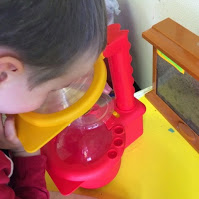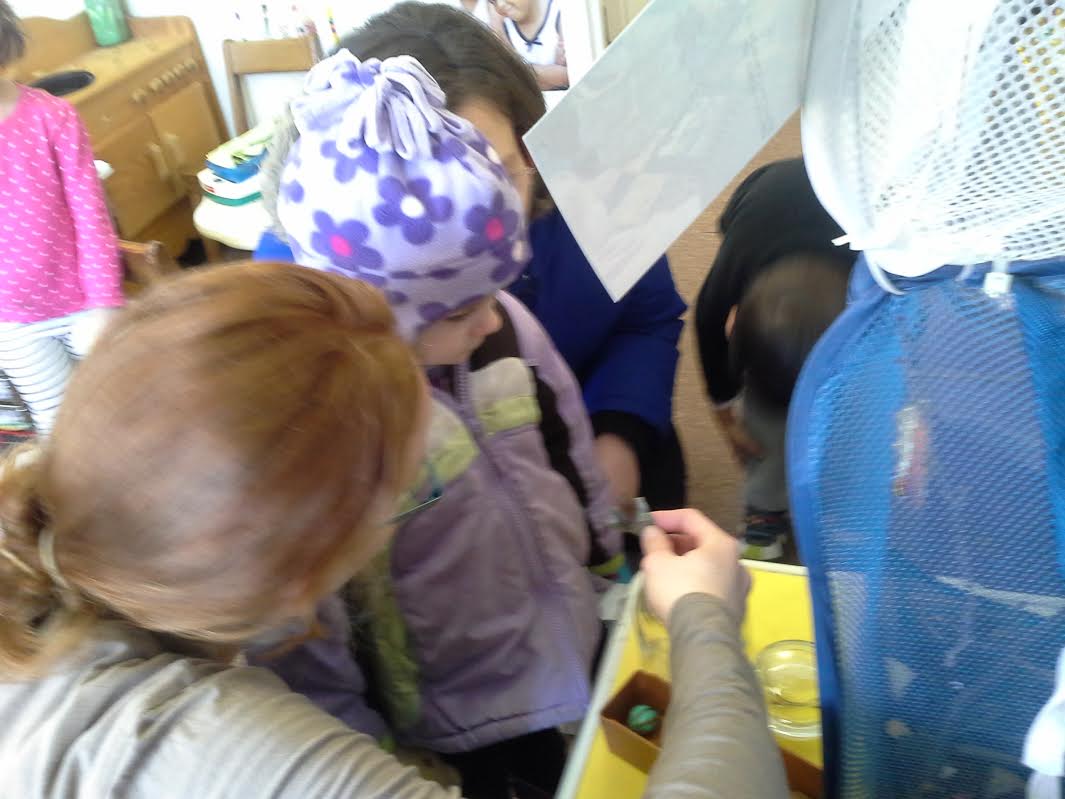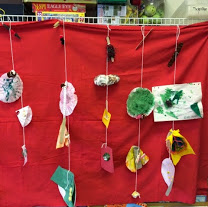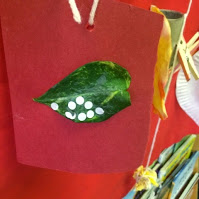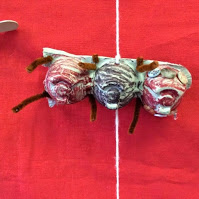Following children's interests; following a caterpillar over winter
By Peggy Ashbrook
Posted on 2015-03-18
It’s always interesting to hear how other early childhood educators make the most of children’s curiosity to teach science concepts. Guest blogger Maggie Posey is a mom to a curious two year old and preschool teacher to eight eager learners. She blogs about both athttp://www.mamasuerte.blogspot.com. In this guest post she writes about how her preschool students’ interest in a caterpillar led to a month-long investigation.
Welcome Maggie! ~~~~~~~~~~~~~~~~~~~~~~~~~~~~~~~~~~~~~~~~~~~~~~~~~
 I am not much of a bug person. In fact, creepy crawly things are just that to me—creepy. However, in October when one of my students asked if we could care for a caterpillar she found on the way to school, I decided to put my hesitation aside and explore her interest. Caterpillars quickly became an interest of all the children in my class, as they gathered around the new class “pet’, reaching for it and wanting to hold it.
I am not much of a bug person. In fact, creepy crawly things are just that to me—creepy. However, in October when one of my students asked if we could care for a caterpillar she found on the way to school, I decided to put my hesitation aside and explore her interest. Caterpillars quickly became an interest of all the children in my class, as they gathered around the new class “pet’, reaching for it and wanting to hold it.
At first, I strongly encouraged my students, eight almost four-year-olds, NOT to touch the caterpillar. I remembered hearing somewhere that they could be poisonous or stick your skin like cacti. Searching online I found the Discover Life website with pages for identifying caterpillars (note that not all caterpillars are listed on the site). As I checked 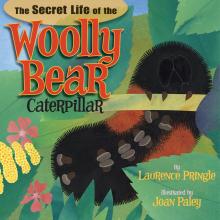 boxes detailing specific information about it like hairy body, brown hair, found in Virginia, the website narrowed the results until I was able to easily pick out an image of our caterpillar. After identifying our caterpillar as a Woolly Bear Caterpillar and eagerly researching this breed, I realized that it was harmless. Searching online, I found The Secret Life of the Woolly Bear Caterpillar by Laurence Pringle (2014). This book became the main resource for our adventures with Woolly Bear. Using the information we learned in
boxes detailing specific information about it like hairy body, brown hair, found in Virginia, the website narrowed the results until I was able to easily pick out an image of our caterpillar. After identifying our caterpillar as a Woolly Bear Caterpillar and eagerly researching this breed, I realized that it was harmless. Searching online, I found The Secret Life of the Woolly Bear Caterpillar by Laurence Pringle (2014). This book became the main resource for our adventures with Woolly Bear. Using the information we learned in 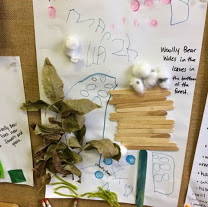 that book, my children designed a plan for a habitat using paper, cotton balls (to represent rocks), leaves, stickers, markers, and pretty much any other art materials
that book, my children designed a plan for a habitat using paper, cotton balls (to represent rocks), leaves, stickers, markers, and pretty much any other art materials 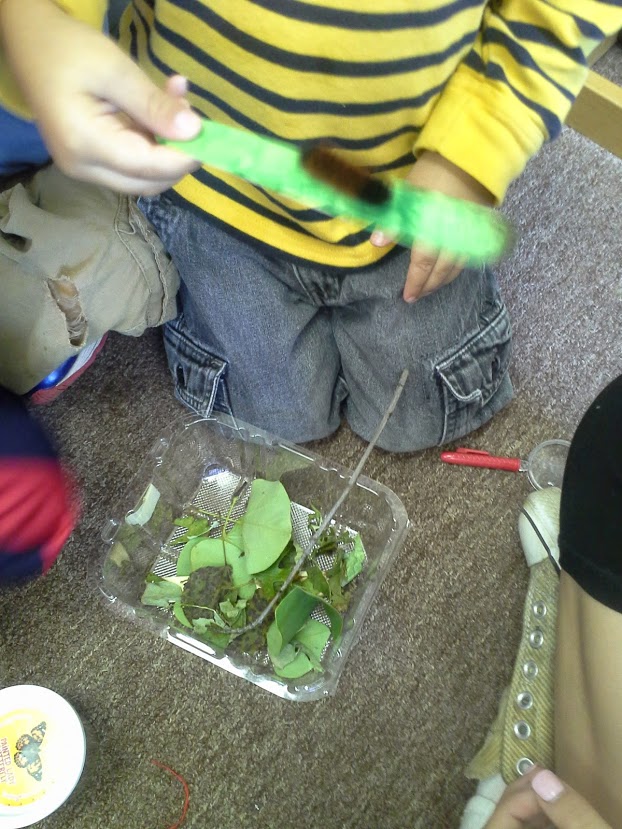 they thought was necessary. Using the plans they made, we built the real habitat: a plastic container without a lid with rocks, dirt, sticks, and green leaves. I found the “What Do Caterpillars Eat” website to be a helpful guide, along with our book, in determining what to feed Woolly Bear. The Peterson First Guide to Caterpillars of North America is another good resource. Daily, the kids found green leaves for Woolly Bear at the playground or on their walks to school, adding their collections to the container. We also made three dimensional models of Woolly Bear, as we called it, observing the creature with magnifying glasses in and out of its habitat for inspiration.
they thought was necessary. Using the plans they made, we built the real habitat: a plastic container without a lid with rocks, dirt, sticks, and green leaves. I found the “What Do Caterpillars Eat” website to be a helpful guide, along with our book, in determining what to feed Woolly Bear. The Peterson First Guide to Caterpillars of North America is another good resource. Daily, the kids found green leaves for Woolly Bear at the playground or on their walks to school, adding their collections to the container. We also made three dimensional models of Woolly Bear, as we called it, observing the creature with magnifying glasses in and out of its habitat for inspiration.
As winter crept up on us, we noticed a lack of green foliage outside. Cabbage, lettuce, and plantains replaced leaves on Woolly Bear’s menu. Cue a tangent lesson on changing seasons! From Pringle’s book, we knew that Woolly Bear Caterpillars usually hibernate, but our Woolly Bear kept moving around! We wondered what would happen to Woolly Bear. 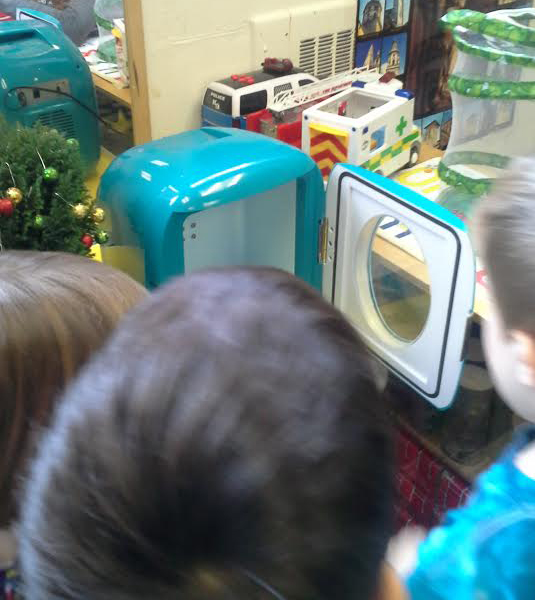 Could it somehow hibernate inside our room? Should we release it? What would happen if Woolly Bear didn’t hibernate? Could it still mature to a moth? I asked Peggy Ashbrook for some guidance, and she became known as the “expert” in our class. [Note from Peggy: I am not an expert but I was able to suggest some resources!] Having an expert was helpful. When my students asked me a question I didn’t know the answer to, they would suggest that I ask the “expert” or use other “resources” like our book or the Internet. After considering our options, and voting on our preferences, the kids decided to place the habitat in a small fridge in our room. Over Christmas break, Woolly Bear remained in the fridge. When we got back to school, we noticed that it had moved, not settling down under the rocks as we expected. It did not hibernate.
Could it somehow hibernate inside our room? Should we release it? What would happen if Woolly Bear didn’t hibernate? Could it still mature to a moth? I asked Peggy Ashbrook for some guidance, and she became known as the “expert” in our class. [Note from Peggy: I am not an expert but I was able to suggest some resources!] Having an expert was helpful. When my students asked me a question I didn’t know the answer to, they would suggest that I ask the “expert” or use other “resources” like our book or the Internet. After considering our options, and voting on our preferences, the kids decided to place the habitat in a small fridge in our room. Over Christmas break, Woolly Bear remained in the fridge. When we got back to school, we noticed that it had moved, not settling down under the rocks as we expected. It did not hibernate.
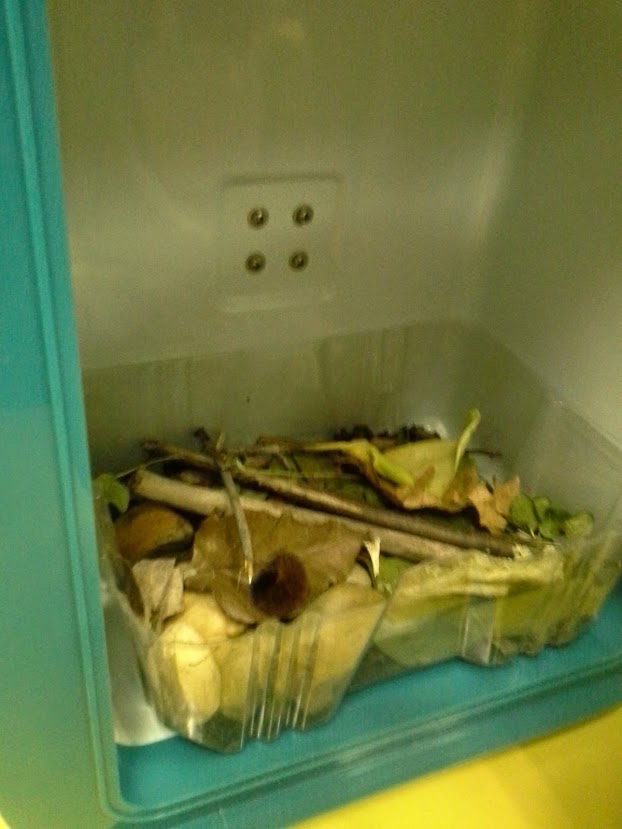 One day when we arrived at school, we couldn’t find Woolly Bear anywhere. We searched and searched. Finally, we noticed a hairy, brown cocoon on the bottom of a leaf. We were so excited! The students again made three-dimensional models of Woolly Bear, this time in the cocoon stage. In anticipation of its metamorphosis, we made a new habitat using laundry hampers with ample space for a moth to fly around. We waited and waited and waited.
One day when we arrived at school, we couldn’t find Woolly Bear anywhere. We searched and searched. Finally, we noticed a hairy, brown cocoon on the bottom of a leaf. We were so excited! The students again made three-dimensional models of Woolly Bear, this time in the cocoon stage. In anticipation of its metamorphosis, we made a new habitat using laundry hampers with ample space for a moth to fly around. We waited and waited and waited.
Twelve days later, we noticed a tiny hole at one end of the cocoon. Searching around our makeshift terrarium, we found our Isabella Tiger Moth! The students shared fresh fruit from their lunches for the moth to drink the juice, observed its behavior, made new 3D models of this life stage, and wondered what would happen next. In preparation for what I knew was coming quickly (Woolly Bear’s death), I talked a lot to my students about how moths only live for a short time. Three days later, we found Woolly Bear face up, wings spread. Although our Isabella Tiger moth had died, the kids were thrilled to learn that our caterpillar was a girl; she had laid eggs! In the corner of our habitat there were about fifty eggs, almost too tiny to pick up, but perfect for viewing under a microscope. Through research, we learned the eggs were sterile; two of these moths are needed to make new woolly bears.
As our journey came to an end, we made models of the eggs and added all of our models to life cycle mobiles. We disassembled our habitats and discussed all we had learned. From new vocabulary and knowledge of life cycles to different types of habitats and the process of scientific inquiry, following my student’s interest led to deep, multifaceted learning, and it expanded my comfort zone!
Disclaimer: The views expressed in this blog post are those of the author(s) and do not necessarily reflect the official position of the National Science Teaching Association (NSTA).



